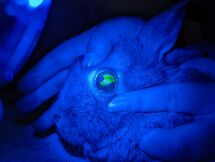Conjunctivitis
Rabbit conjunctivitis is often also known as weepy eye or pink eye. Conjunctivitis is defined as the inflammation of the conjunctiva, a mucous membrane that covers the front portion of the eye and lines the lids and third eyelid.
Epiphora, an abnormal overflow of tears onto the face, can occur in rabbits without conjunctivitis.
Symptoms
Signs of the disease include the following:[1]
- involuntary tight closure of the eyelids (blepharospasm).
- redness in the eye
- ocular discharge - transparent or pale yellow fluid, mucoid, or containing both mucus and pus
- excessive conjunctival tissue that may partially or completely cover the cornea
- signs of pain such as reluctance to move, depression, lethargy, hiding, and hunched posture
- alopecia, crusts, and matted fur around the eye, cheeks, and/or nose
Historical signs of the disease include the following:[1]
- history of previous treatment for dental disease
- history of nasal discharge or previous upper respiratory infection
- facial asymmetry, masses, or protrusion of the eyeballs in rabbits with tooth root abscesses
Causes
Infectious agents that have been associated with conjunctivitis include the following:[2]
- most commonly Staphylococcus, Micrococcus, and Bacillus species.
- less commonly Bordetella, Stomatococcus, Neisseria, Pasteurella, Corynebacterium, Streptococcus, and Moraxella species.
- Staphylococcus aureus, Pseudomonas species, Haemophilus species, Treponema paraluiscuniculi, mycoplasmas, chlamydiae, and myxoma virus.
Other reasons that can cause conjunctivitis include the following:[2]
- foreign bodies
- entropion (a genetic condition in which a portion of the eyelid is inverted or folded inward) - common in Rex and New Zealand breeds.[1]
- distichia (an eyelash that arises from an abnormal location on the eyelid or grows in an abnormal direction)
- trichiasis (a common eyelid abnormality in which the eyelashes are misdirected and grow inwards toward the eye) - common in Rex and New Zealand breeds.[1]
- glaucoma - common in dwarf and Himalayan breeds.[1]
- high ammonia and dust content in the environment
- dental disease, including root elongation and dental abscesses - common in young animals and dwarf and lop breeds.[1]
Treatment
For a simple initial at-home treatment, owners can flush the eye with a sterile saline solution, often easily available at the local pharmacy and marketed for contact lenses. This will help clean out any foreign bodies that may be acutely irritating the eye. If flushing the eye does not improve the situation, then the rabbit should be taken to a rabbit-savvy vet as soon as possible for further diagnosis and treatment.
A nasolacrimal duct irrigation may be necessary if an obstruction is diagnosed. If the duct is blocked or inflamed, irrigation of the duct often needs to be repeated either daily for 2 to 3 consecutive days or once every 3 to 4 days until irrigation produces a clear fluid. Failure to keep ducts open can result in scarring or permanent obstruction.[1]
Common drugs that can be prescribed for conjunctivitis include the following:[1]
- broad-spectrum topical antibiotic
- topical triple antibiotic, chloramphenicol, gentamicin, or ciprofloxacin every 6 to 12 hours depending on severity
- systemic antibiotics for rabbits with tooth root abscesses or upper respiratory infections
- topical nonsteroidal antiinflammatory agents such as 0.03% flurbiprofen or 1% diclofenac
- artificial tears and lubricant ointments to relieve dryness
- 0.2% cyclosporine A to increase tear production. Should be used with discretion as information on use in rabbits is limited.
Owners should help keep the fur around the face clean and dry, especially if copious discharge is noted. If solutions and ointments are both prescribed, the solutions should be used before ointments. Several minutes should pass between treatments.[1]
Topical corticosteroids should never be used if the cornea retains fluorescein stain or if there is evidence of a local or systemic bacterial infection.[1]
Further reading
- My House Rabbit, Julien Poublon, DVM MRCVS, Conjunctivitis in Young Rabbits
- Lauren Beyenhof, Conjunctivitis in rabbits: Symptoms and treatment
- Merck Veterinary Manual, Disorders and Diseases of Rabbits > Eye and Ear Disorders



